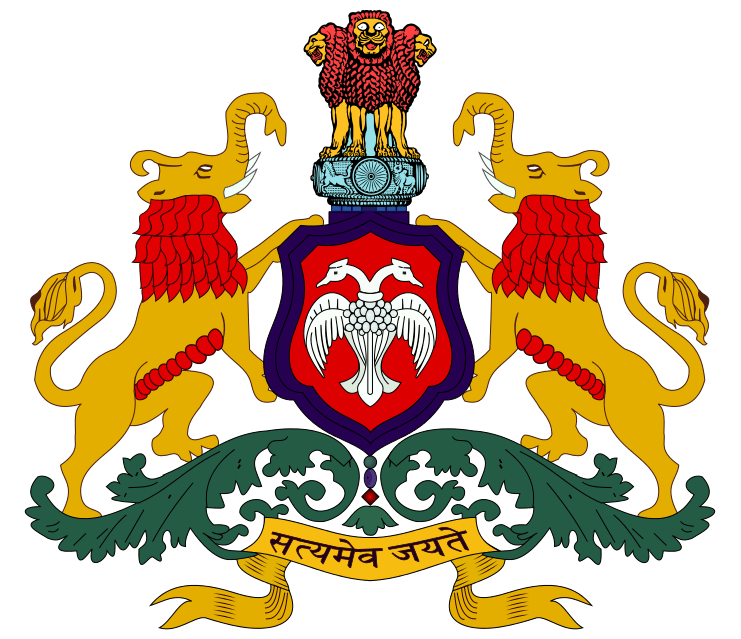Government of Karnataka
The Government of Karnataka, officially known as, Karnataka Rajya Sarakara, is a democratically elected body with the governor as the constitutional head. The governor who is appointed for five years appoints the chief minister and on the advice of the chief minister appoints his council of ministers. Even though the governor remains the ceremonial head of the state, the day-to-day running of the government is taken care of by the chief minister and his council of ministers in whom a great amount of legislative powers are vested.
Administrative divisions
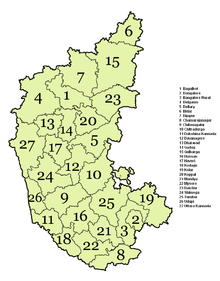
Karnataka State has been divided into four revenue divisions, 49 sub-divisions, 30 districts, 237 taluks and 747 hoblies/revenue circles and 5628 gram panchayats for administrative purposes.[2] The state has 281 towns and 7 municipal corporations. Bangalore is the first largest urban agglomeration out of 23 metropolis, urban agglomerations and cities in India. It is among the fastest growing cities in the world.
Political and administrative reorganisation
Karnataka took its present shape in 1956, when the states of Mysore and Coorg (Kodagu) were merged with the Kannada-speaking districts of the former states of Bombay and Hyderabad, and Madras. Mysore state was made up of 10 districts: Bangalore, Kolar, Tumkur, Mandya, Mysore, Hassan, Chikmagalur (Kadur), Shimoga and Chitradurga; Bellary had been transferred from Madras state to Mysore in 1953, when the new Andhra State was created out of Madras' northern districts. Kodagu became a district, and Dakshina Kannada (South Kanara) district was transferred from Madras state, Uttara Kannada (North Kanara), Dharwad, Belgaum District, and Bijapur District from Bombay state, and Bidar District, Kalaburgi District, and Raichur District from Hyderabad state.
In 1989, Bangalore rural district was split from Bangalore and, in 1997, Bagalkot district split from Vijayapur, Chamrajnagar district split from Mysore, Gadag district split from Dharwad, Haveri district split from Dharwad, Koppal district split from Raichur, Udupi district split from Dakshina Kannada, and Davanagere district was created from parts of Bellary, Chitradurga, Dharwad, and Shimoga.
E-Governance
Department of Higher Education
- The department has launched two youtube channels Vijayeebhava and Jnananidhi as a part of e-learning initiative.[3]
- Higher education department launched a free, crash course app called GetCETGo on April 20, 2020 to prepare students for Common Entrance Test and National Eligibility cum Entrance Test (Undergraduate).[4]
Department of Rural development and Panchayat raj
Department of Rural development and panchayat raj has launched Kayaka Mitra app on April 30, 2020 through which MNREGA job card holders can submit demand for work.[5]
Revenue Department
Directorate of Atal Janasnehi Kendra
- E-kshana is a project aimed at delivering instantaneous over-the-counter digitised caste, income, and residence certificates. The project is aadhar linked ration card database that maps nearly five crore population with their residence, caste and income. It has been created by IAS officer Mr. Munish Maudgil, Commissioner of Survey Settlement and Land Records. The database belongs to Atal Janasnehi Kendra (AJSK) of the Revenue Department.[6][7][8]
Department of Stamps and Registration
- Maulya app has been launched by Department of Stamps and Registration to help citizens to know the guidance value of any immovable property.[9][10][11]
- The department has launched Kaveri Online Services on 16 November 2018 aimed at making easy accessible and quick delivery of citizen services such as Encumbrance Certificate (EC) of the immovable properties, registration and delivery of documents of sale of immovable properties, mortgage, lease, power of attorney and marriage etc as well as Certified Copies (CC) of the registered documents.[12][13][14]
- Dishaank app will use user's location using GPS and provides the survey number of a plot as well as details of ownership. The app superimposes the survey number of all properties over satellite maps. The app was built by Karnataka State Remote Sensing Application Centre.[15][16][17][18]
- Department of Hindu Religious Institutions and Charitable Endowment(Muzrai)
- The department launched website PurePrayer.com and a mobile app PurePrayer which allows devotees to book sevas, temple specific rituals and pujas as per the prescribed charges by the temples.[19][20]
Department of Public Libraries
Department of Public Libraries launched web-based and app-based digital library for the public in February 2020. The web portalwww.karnatakadigitalpubliclibrary.org and the app e-Sarvajanika Granthalaya allows public to freely access digital content. [21]
Others
- "e-spandana" is a hi-tech video conferencing video conferencing initiative of the Karnataka Government which provides one-to-one interaction between gram panchyats and district headquarters. It has been launched as a part of "Government at the doorstep of rural masses".[22][23]
- "e-Janaspandana" is a Karnataka Government's Public Grievance Redressal System which allows citizens to lodge complaint of any department under Sakala act.[24] [25]
- "Spandana" is a web portal based public grievance redressal system launched to address the complaints of Hassan district people on January 1, 2018.[26]
- Mahiti Kanaja is public information disclosure platform aimed at standardisation of data pertaining to all 30,000 villages in the state in order to improve governance. Under this every village, taluk, and district will get a common code.[27]
- Sidilu is an app launched by Karnataka State Natural Disaster Monitoring Centre (KSNDMC) and the revenue department in association with U.S based firm Earth Networks on 13 April 2018 to alert people about lightning strikes 45 minutes in advance.[28][29][30][31]
- Bengaluru Megha Sandesha is an app launched Karnataka State Natural Disaster Monitoring Centre in collaboration with Indian Institute of Science to give rainfall and weather updates of Bengaluru.[32]
- Pratibimba is a dashboard that showcases the performance of the government
- Bele Darshak is an app by agriculture department that will let farmers to know the data related to crop survey done on their farms.[33]
Legislature
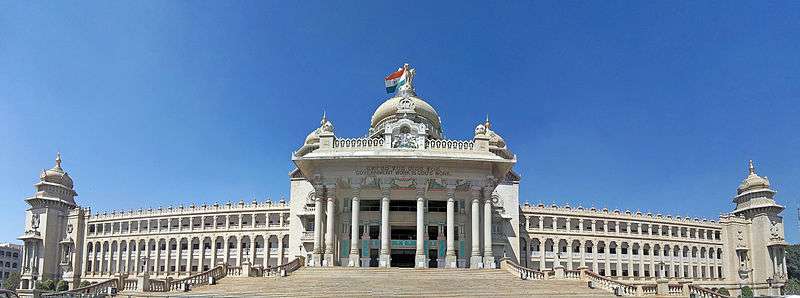
The state legislature is bicameral and consists of the Legislative Assembly and the Legislative Council. The Legislative Assembly consists of 224 members with one member nominated by the governor to represent the Anglo-Indian community. The term of office of the members is five years and the term of a member elected to the council is six years.[34] The Legislative Council is a permanent body with one-third of its members retiring every two years.[35]
Ministry
The government is headed by the governor who appoints the chief minister and his council of ministers. The governor is appointed for five years and acts as the constitutional head of the state. Even though the governor remains the ceremonial head of the state, the day-to-day running of the government is taken care of by the chief minister and his council of ministers in whom a great deal of legislative powers is vested..
The secretariat headed by the secretary to the governor assists the council of ministers. The council of ministers consists of cabinet ministers, ministers of state and deputy ministers. The chief minister is assisted by the chief secretary, who is the head of the administrative services.
As of February 2020, the Government of Karnataka consists of 28 ministers including Chief Minister and 3 Deputy Chief Ministers.
Chief Minister
The Chief Minister of Karnataka is the chief executive of the Indian state of Karnataka. As per the Constitution of India, the governor is a state's de jure head, but de facto executive authority rests with the chief minister. Following elections to the Karnataka Legislative Assembly, the state's governor usually invites the party (or coalition) with a majority of seats to form the government. The governor appoints the chief minister, whose council of ministers are collectively responsible to the assembly. Given that he has the confidence of the assembly, the chief minister's term is for five years and is subject to no term limits.[36]
Cabinet
| Designation/Portfolio | Portrait | Minister |
|---|---|---|
| Chief Minister
DPAR, Finance, Bengaluru development, Energy, Intelligence from Home, Small scale Industries, Planning, Information and Public Relations and all unallocated portfolios |
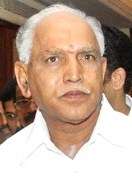 |
B. S. Yediyurappa |
| Deputy Chief Minister
Minister of Public Works Department, |
Govind M. Karjola | |
| Deputy Chief Minister
Minister of Higher Education, |
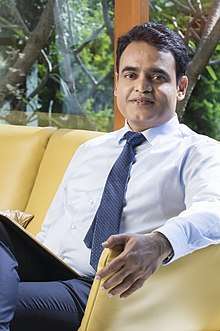 |
Dr. C. N. Ashwath Narayan |
| Deputy Chief Minister
Minister of Transport |
.jpg) |
Laxman Savadi |
| Minister of Home Department excluding Intelligent Wing |
_(cropped).jpg) |
Basavaraj Bommai |
| Minister of Rural Development and Panchayat Raj | 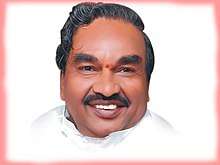 |
K.S.Eshwarappa |
| Minister of Revenue Department excluding Muzrai | R. Ashoka | |
| Minister of Large and Medium Scale Industries excluding Sugar, Minister of Public Enterprise Department |
.jpg) |
Jagadish Shettar |
| Minister of Health and Family Welfare excluding Medical Education, Minister of Backward Class Welfare Department |
B. Sriramulu | |
| Minister of Primary & Secondary Education and Sakala | 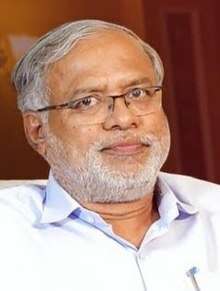 |
S.Suresh Kumar |
| Minister of Housing Department | V.Somanna | |
| Minister of Tourism, Minister of Kannada and Culture, Minister of Youth Empowerment & Sports |
C. T. Ravi | |
| Minister of Muzrai from Revenue Department, Minister of Fisheries, Ports and Inland Transport Department |
Kota Srinivas Poojary | |
| Minister of Law, Parliamentary affairs and Legislation, Minister of Minor Irrigation from Water Resources Department |
J. C. Madhu Swamy | |
| Minister of Mines & Geology from Commerce & Industries Department | C. C. Patil | |
| Minister of Animal Husbandry, Minister of Haj and Wakf Department |
Prabhu Chauhan | |
| Minister of Women and Child Development, Minister of Empowerment of differently Abled and Senior Citizens |
Shashikala Annasaheb Jolle | |
| Minister of Excise | H. Nagesh | |
| Minister of Major and Medium Irrigation from Water Resources Department | .jpg) |
Ramesh Jarkiholi |
| Minister of Ecology & Environment Department, Minister of Forest Department |
Anand Singh | |
| Minister of Textiles from Commerce and Industries Department, Minister of Minority Welfare |
Shrimant Balasaheb Patil | |
| Minister of Food, Civil Supplies and Consumer Affairs Department | K. Gopalaiah | |
| Minister of Urban Development Department (Excluding Bengaluru development, BBMP, BDA, BWSSB, BMRDA, BMRCL, KUWSDB, KUIDFC & Directorate of Town Planning from Urban Development) | Byrati Basavaraj | |
| Minister of Co-Operation | S. T. Somashekhar | |
| Minister of Agriculture | B. C. Patil | |
| Minister of Medical Education from Health & Family Welfare Department | Dr. K. Sudhakar | |
| Minister of Municipal Administration, Minister of Horticulture and Sericulture |
Narayana Gowda | |
| Minister of Labour Department, Minister of Sugar from Commerce & Industries Department |
Arbail Shivaram Hebbar | |
Karnataka Panchayat Raj
(Rule of Village Committee) is a three-tier system in the state with elected bodies at the village, taluk and district levels. It ensures greater participation of people and more effective implementation of rural development programmes. There will be a Grama Panchayat for a village or group of villages, a taluk level and the Zilla Panchayat at the district level.
All the three institutions will have elected representatives and there is no provision for nomination by the government to any of these councils. s the first in the country to enact new Panchayat Raj Act incorporating all provisions of 73rd Amendment to the Constitution. In 2014 Karnataka State Grama Panchayats Delimitation committee constituted By govt. of Karnataka. Chairmen S G Nanjaiahna mutt and 6 members. joint secretory of the committee Dr.Revaiah Odeyar. Report Submitted 2014 October 30. This report implemented 2015 Gram Panchayath Elections.
Executive
A district of an Indian state is an administrative unit headed by a deputy commissioner or district magistrate, an officer belonging to the Indian Administrative Service. The district magistrate or the deputy commissioner is assisted by a number of officers belonging to Karnataka Civil Service and other Karnataka state services.
A Deputy Commissioner of Police, an officer belonging to the Indian Police Service is entrusted with the responsibility of maintaining law and order and related issues of the district. The commissioner is assisted by the officers of the Karnataka Police Service and other Karnataka Police officials. A Deputy Conservator of Forests, an officer belonging to the Indian Forest Service, is responsible for managing the forests, environment and wildlife related issues of the district. He is assisted by the officers of the Karnataka Forest Service and other Karnataka forest and wildlife officials. Sectoral development is looked after by the district head of each development department such as PWD, Health, Education, Agriculture, Animal husbandry, etc. These officers belong to the State Services.
Police Administration
The state is divided into 30 police districts, 77 sub-divisions, 178 circles, State Police consists of 20 police districts, 5 Police Commissioners at Bangalore, Mysore, Mangalore, belgaum and Hubli-Dharwad cities, 77 sub-divisions, 178 circles, 696 police stations, and 317 police outposts. There are five ranges: Central Range at Bangalore, Eastern Range at Davanagere, Northern Range at Gulbarga, Southern Range at Mysore and Western Range at Mangalore. The government Railway Police is headed by a D.I.G. of Police.[38]
Units that assist the state in law and order include Criminal Investigation Department (Forest Cell, Anti-Dowry Cell, etc.), Dog Squad, Civil Rights Enforcement Wing, Police Wireless and Police Motor Transport Organization and special units. Village Defence Parties protect persons and property in the village and assist the police when necessary. The police force is at times supplemented by Home Guards.
Politics
Karnataka politics is dominated by the Bharatiya Janata party (BJP).
In recent election conducted in May 2018 BJP emerged as single largest party with 104 seats leaving behind INC with 79, JDS with 38, BSP with 1 and other 2 independent seats. While B. S. Yeddyurappa went ahead with the intention of making the government and requested the governor to allow him to form a government without the numbers though. Governor allowed him to take oath as Chief Minister on 17 May 2018 although his happiness was short lived as SC struck down 2 weeks of time provided by the governor for the floor test to just 2 days. He was forced to resign unable to prove the majority. After his resignation H. D. Kumaraswamy was sworn in as the Chief Minister on 23 May 2019 with absolute majority support from Congress total of 117.
In later bypolls JDS+Congress combine won 4 out of 5 seats 3MP & 2 MLA seats making the numbers up by 119.
On 23 July 2019 the government headed by H. D. Kumaraswamy fell short of majority in the trust vote due to the resignation of 17 MLAs from the Congress and the JDS.
B. S. Yeddiyurappa once again took oath as the chief minister for the 4th time on 26 July 2019.
Elections
Last assembly elections: 2018 Karnataka Legislative Assembly election
The by-elections for the 15 constituencies : 2019 Karnataka Legislative Assembly by-elections
See also
- Karnataka
- List of Chief Ministers of Karnataka
- 2019 Karnataka political crisis
References
- "Karnataka CM Yediyurappa names 3 deputy CMs, allocates Cabinet portfolios". India Today. 26 August 2019. Retrieved 11 January 2020.
- "Statistics - Karnataka state". Online webpage of the Forest Department. Government of Karnataka. Archived from the original on 27 September 2007. Retrieved 4 June 2007.
- "UG, PG semester exams tentatively scheduled for June: Dy. CM". The Hindu. 16 April 2020. Retrieved 2 May 2020.
- P, Kumaran PKumaran; May 14, Bangalore Mirror Bureau | Updated:; 2020; Ist, 06:00. "GetCETGo App: Government app for Karnataka Common Entrance Test (K-CET) is a hit". Bangalore Mirror. Retrieved 15 May 2020.CS1 maint: extra punctuation (link) CS1 maint: numeric names: authors list (link)
- "'ಕಾಯಕ ಮಿತ್ರ' ಆ್ಯಪ್ ಬಿಡುಗಡೆ | ನರೆಗಾ ಕೂಲಿ ಬೇಡಿಕೆ ಸರಳೀಕರಣ". Prajavani. 1 May 2020. Retrieved 18 May 2020.
- Srivatsa, Sharath S. (18 February 2020). "Claim over ration card database puts two departments at odds". The Hindu. ISSN 0971-751X. Retrieved 21 May 2020.
- "ತಕ್ಷಣ ಪ್ರಮಾಣ ಪತ್ರ ವಿತರಿಸಲು ಇ-ಕ್ಷಣ - As soon as the certificate to distribute the E-moment". Vijaya Karnataka (in Kannada). Retrieved 21 May 2020.
- thenewsminute.com https://www.thenewsminute.com/article/ias-officer-munish-moudgil-transferred-after-survey-reforms-karnataka-118140?amp. Retrieved 21 May 2020. Missing or empty
|title=(help) - "Launch of Karnataka's flagship digital services put off". Deccan Herald. 12 November 2018. Retrieved 16 May 2020.
- Correspondent, Special (12 November 2018). "An online toolkit for property registration in Karnataka". The Hindu. ISSN 0971-751X. Retrieved 16 May 2020.
- PTI (14 June 2019). "Karnataka unveils online building plan approval facility". Housing News. Retrieved 16 May 2020.
- "KA-ONLINE REGISTRATION(MES1)". https://www.outlookindia.com/. Retrieved 22 May 2020. External link in
|website=(help) - "'ಕಾವೇರಿ– ಆನ್ಲೈನ್' ಸೇವೆ ಆರಂಭ". Prajavani. 17 November 2018. Retrieved 22 May 2020.
- "Karnataka CM launches Kaveri Online Services for property and document related services". The Economic Times. 16 November 2018. Retrieved 22 May 2020.
- "Land info app launched - Bangalore Mirror". bangaloremirror.indiatimes.com. Retrieved 23 May 2020.
- "Dishaank app helps you check Karnataka land records - Times of India". The Times of India. Retrieved 23 May 2020.
- "what is dishank app: ನೀವು ದಿಶಾಂಕ್ ಅಪ್ಲಿಕೇಶನ್ ಬಳಸುತ್ತಿದ್ದೀರಾ? - are you using dishank app; all you should know about the app". Vijaya Karnataka (in Kannada). Retrieved 23 May 2020.
- "Dishaank set to be state's most apt property App ever". Deccan Herald. 28 March 2018. Retrieved 23 May 2020.
- "Karnataka to open temples from June 1". The Week. Retrieved 27 May 2020.
- "Cycle Pure Agarbathies launches PurePrayer app for devotees; solution to help book pujas, services at 52 major temples in Karnataka". Firstpost. Retrieved 27 May 2020.
- "Department of Public Libraries comes up with Digital Library". Star of Mysore. 9 April 2020. Retrieved 8 June 2020.
- "Karnataka Govt launches 'e-Spandana'". @businessline. Retrieved 8 May 2020.
- Kar, Sanghamitra. "Karnataka govt. enhances accountablility with e-Spandana". CIOL. Retrieved 8 May 2020.
- Editor (25 May 2015). "Public Grievance Redressal System for Karnataka". All About Belgaum. Retrieved 8 May 2020.CS1 maint: extra text: authors list (link)
- "Information technology enables a people-friendly Janaspandana". The Hindu. ISSN 0971-751X. Retrieved 8 June 2020.
- "Now, people can air public grievances through 'Spandana'". Deccan Herald. Retrieved 8 May 2020.
- "Karnataka tackles key data challenge to improve governance". Deccan Herald. 7 February 2020. Retrieved 23 May 2020.
- "ಮಳೆಗಾಲದಲ್ಲಿ ಬೀಳುವ ಸಿಡಿಲುಗಳ ಬಗ್ಗೆ ನಿಖರ ಮುನ್ಸೂಚನೆ ನೀಡಲಿದೆ ಈ ಆಪ್! Karnataka Sidilu app alert people before lightning strikes - Kannada Gizbot". kannada.gizbot.com (in Kannada). 14 June 2019. Retrieved 25 May 2020.
- Reporter, Staff (14 April 2018). "Launched: App that can predict lightning strikes". The Hindu. ISSN 0971-751X. Retrieved 25 May 2020.
- Singh, Amrit Pal (15 April 2018). "Karnataka government released Sidilu App to alert citizens before Lightning". Agatton. Retrieved 25 May 2020.
- "Lightning alert app fails to a strike chord in Karnataka". The New Indian Express. Retrieved 25 May 2020.
- "Karnataka Bengaluru Coronavirus Live Updates: KSNDMC, IISc launch Bengaluru weather app, Bengaluru Megha Sandesha". The Indian Express. 6 June 2020. Retrieved 6 June 2020.
- "1.50 lakh farmers raise objections to crop survey data". Deccan Herald. 2 March 2020. Retrieved 16 June 2020.
- A Jayaram. "Council polls may not give Congress majority". Online Edition of The Hindu, dated 2002-05-31. 2002, The Hindu. Retrieved 4 June 2007.
- "Karnataka Legislative Council". Online webpage of Legislative bodies in India. Government of India. Retrieved 4 June 2007.
- Durga Das Basu. Introduction to the Constitution of India. 1960. 20th Edition, 2011 Reprint. pp. 241, 245. LexisNexis Butterworths Wadhwa Nagpur. ISBN 978-81-8038-559-9. Note: although the text talks about Indian state governments in general, it applies for the specific case of Karnataka as well.
- https://www.indiatoday.in/india/story/karnataka-cm-yediyurappa-expands-cabinet-inducts-10-ministers-1643780-2020-02-06
- karnatakastatepolice.org - de beste bron van informatie over karnataka state police. Deze website is te koop
External links
- Official website
- https://web.archive.org/web/20070311212509/http://www.kar.nic.in/kla/histry.htm
- http://www.karnataka.com/govt/
- https://web.archive.org/web/20100619201924/http://kla.kar.nic.in/cabm.htm
- Police
- Judiciary
- http://www.ebc-india.com/lawyer/hcourts.htm
- http://pib.nic.in/archieve/lreleng/lyr2003/roct2003/30102003/r301020037.html
- http://karnatakajudiciary.kar.nic.in/
- Transport
- http://www.rto.kar.nic.in Transport Department - All RTO's in Karnataka
- LNG
